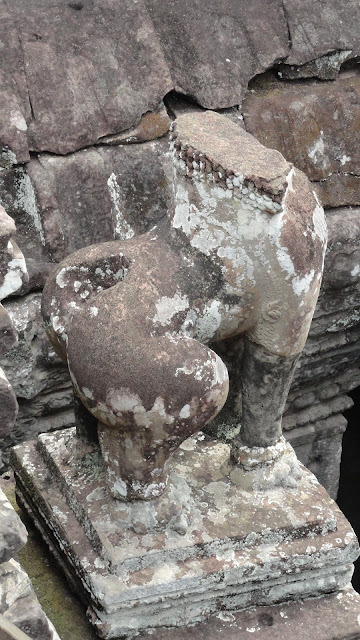Sopheap picked us up early Saturday morning for a short drive (8 kilometers north of Siem Reap) to Angkor Thom. Angkor Thom (meaning "Great City") was the last and most long-lasting capital city of the Khmer Empire. Ankgor Thom was built by King Jayavarman in the late 12th century.
Sopheap parked the car just outside the South gate to Angkor Thom. There are 5 gates into Angkor Thom, all but one of which lead to The Bayon, King Jayavarman's state temple, at the center of the city. As you can see in the map below, there are many other temples located within the Angkor Thom complex.
The entire Angkor Thom complex (an area of 9 square kilometers) is surrounded by a moat and a wall that is 8 meters high wall. Boats on the edge of the moat.
Looking over the moat to the South Gate of Angkor Thom.
On the left side of the causeway over the moat and leading to the South gate was a row of devas. A deva is a benevolent supernatural being (the "good") in Hinduism. The right side of the causeway featured a row of asuras which, in Hinduism, means the forces of chaos (the "evil") that are in constant battle with the devas. Each row of these figures was holding a portion of a "naga" (the Hindu word for "the great snake" - a king cobra) as if engaged in a tug-of-war. It is thought that this scene represents the popular Angkorian myth "The Churning of the Sea of Milk" or that the serpents are either guardian figures or represent the transition from the world of men to the world of the gods (The Bayon).
The head of the serpent at the beginning of the causeway.
The row of devas holding on to the body of the serpent.
A deva with a missing head, probably stolen by vandals.
At one time, the row of asuras (photo below) also held on to the body of the serpent. However, they are now so badly decayed there wasn't much left to see.
A restoration project on the asura side of the causeway was underway and soon the appearance of that side will be improved. The South gate up close and the first (of many) smiling faces.
After navigating around a small traffic jam, we drove into Angkor Thom to visit The Bayon.
The Bayon was built in the late 12th/early 13th centuries as the official state temple of the Buddhist King Jayavarman VII. It is located exactly at the center of Angkor Thom, the captial of his empire. After King Jayavarman's death, The Bayon was modified and added on to by succeeding Hindu and Buddhist Kings in accordance with their religious preferences.
The Bayon's most distinctive features are the enormous stone faces that are on many of the stone towers. There are a total of 216 faces in the entire temple (54 towers with 4 faces each). Although it is not known for sure, the similarity of the faces on the temple's towers to images of King Jayavarman has led many to believe that the faces are in fact representations of the King himself.
A pair of lions on guard at the entrance to the temple. Immediately behind the lions, you can see the remnants of a pair of "nagas".
Looking up at the towers.
I was a little nervous walking around inside of this temple. It was literally falling apart. Everything was leaning and crumbling. So safe, I am sure.
A "real" smiling face.
The Bayon is also known for having two sets of bas-reliefs on the lowest level.
In the photo below, Sophead is explaining the meaning behind the scene.
I wasn't paying attention but there was something significant about the fact that an elephant was included in the bas-relief. 
Christopher trying to think of what else he can run, jump or climb on.
And then, with Sopheap's blessing, he was off.
Kevin couldn't resist the challenge either.
Caitlynne and I stayed on terra firm. Me with my heart in my throat.
Random photos of things that caught my eye.
I love how the pair of hands is just randomly set on the base of this statue.
And these feet are placed nearby.

As you can see from these photos, this temple was in pretty bad condition. In addition to the various body parts lying around, there were many pieces of the temple just piled up.
Since 1995, the Japanese Government team for the Safeguarding of Angkor (the JSA) has been the main conservatory body of the temple and is restoring it using techniques that combine the reassembly of the decayed pieces and incorporating new materials when necessary. 

On our way out of Angkor Thom (via one of the East Gates), we passed by the Terrace of the Elephants which is where the King sat to view parades and assemblies.
When I began to write this post, I uploaded 121 photos and it has taken me the better part of yesterday afternoon and this morning to sort through them all. When I have a minute (!?!) I need to go back and count exactly how many made the cut.
Have a great Friday!


























































No comments:
Post a Comment